(This article was originally published on 6/11/2024 by Jeni Spring here, and the social media recap from Julie Marciniak was posted 4/16/2025 here and here.)
One of the questions that we Barefoot Massage therapists get asked VERY often is “Can you actually feel knots when you massage with your feet?”
Yes, we can! OF COURSE we can feel things through our feet! It’s not 100% the same as how detailed we can feel things with our hands – but that’s just biologically how humans are made.
Lets help the world better understand how feet have feelings, too!
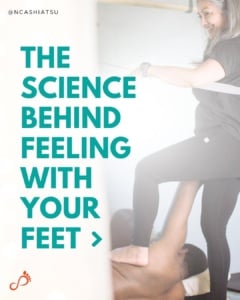
What is in this message!?
- Info summarized from studies and research articles on how feet feel things through haptic perception, the sensory homunculus, mechanoreceptors, proprioception & more
- Activities to hone your own palpation skills
- Self care tips to help your feet “see” more clearly
- Research sited at the end for you to go down the rabbit hole even deeper
Anything hands can do, feet can do (better?)
Our feet are meant to move us across uneven surfaces and varied textures. Think about the difference of walking in your back yards grass, walking on the paved sidewalk, walking on the beach. Even different sand densities or different distances from the water along the sand will completely change the way your feet need to work on that surface to create movement in your body. Nice plush blades of grass, or fine golf course grass, will make you walk differently than that dried up, scratchy spindly grass in the forgotten corners of the elementary school playground. Even without “movement”, standing can be harder on different surfaces, but your feet help you figure that out subconsciously.
Crazy detailed, right? A Barefoot Massage therapist is doing that kind of foot-calibration while they massage a body! We balance, sink, adjust, grip, slide, step, tilt, and mold our feet to meet the “kneads” of the anatomy underfoot based on what is felt through the sensory information gathered by feet. It’s almost like feet have sonar that penetrate into the surfaces below them – which is something that helps us work on the depths of the human body.
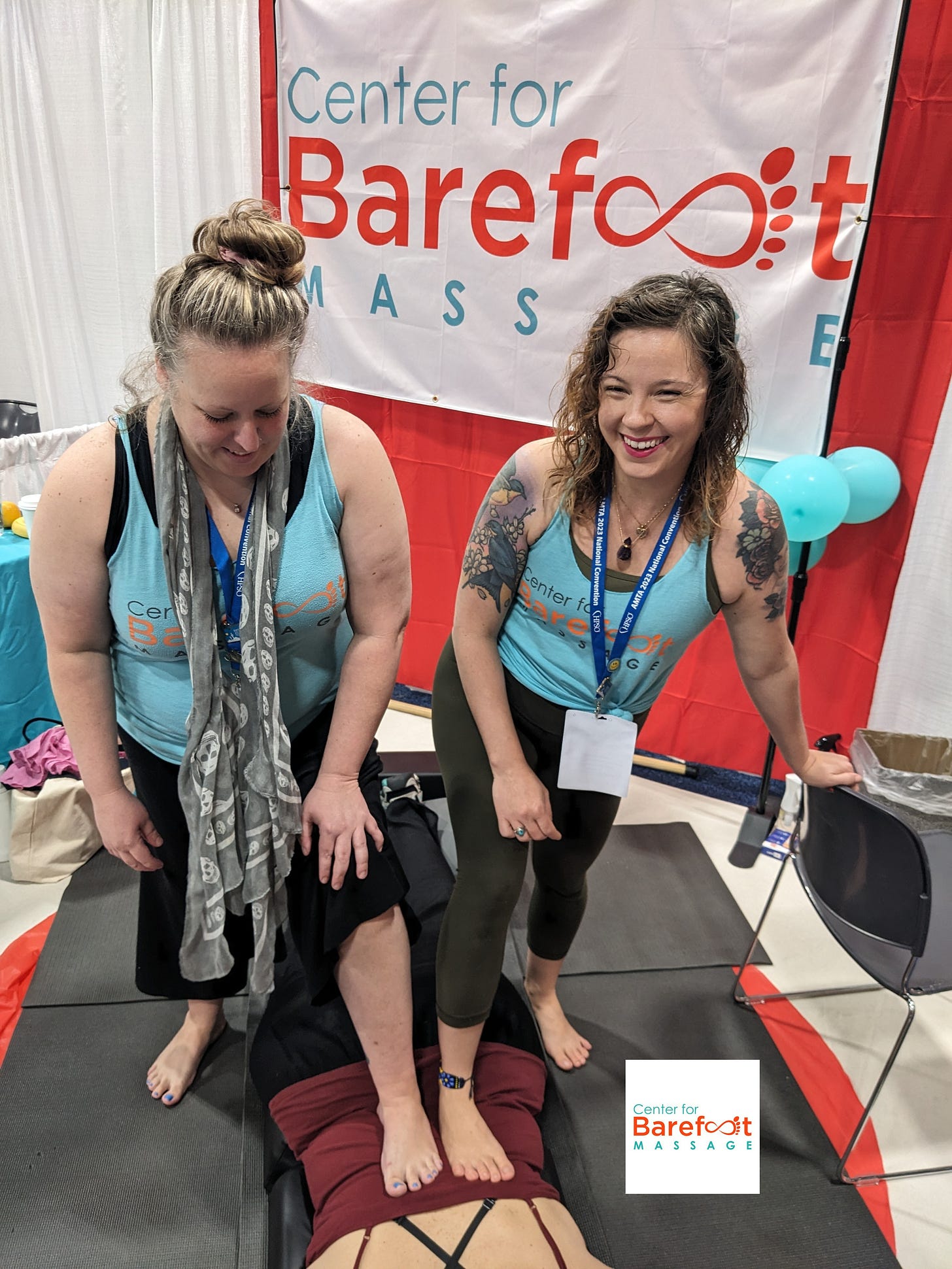
When anyone touches an object, we receive a significant amount of information about it. This capability comes from our skin’s extensive network of nerve endings and touch receptors, which are sensitive to various kinds of stimuli. A stimulus can be any factor that activates the receptors in our skin, such as pressure, temperature, vibrations, or pain. Upon activation by a stimulus, these receptors trigger a series of nerve impulses that are transmitted to our brains. Our brains then process this information to identify the object. However, passive contact with an object is insufficient for identification. To really get a scope on its shape and details, we have to actively explore its surfaces and the object as a whole by moving it in our hands, a process known as haptic perception.
This also happens in our feet! The detail level is different – maybe not “less than hands” but definitely different. The nugget of a summary in one research article that was neat is the following little quote:
Recognition by foot was slower (7 vs. 13 seconds) and much less accurate (9% vs. 47% errors) than recognition by either one or both hands. Nevertheless, item difficulty was similar across hand and foot exploration, and there was a strong correlation between an individual’s hand and foot performance.
The foot still felt and recognized whatever they were doing to it, just at a slower and dulled rate than hands. That’s not exactly what I wanted to hear, but OK. This helps support another reason why a myofascial barefoot massage therapist will want to move as slow as a sloth: so that all parties can perceive things as best as possible. (I still swear I can feel things better with my feet – there’s my bias coming out.)
I often see a quotes floating around about there being something like 10,000 nerves in the sole of the foot, (I even found some posts stating as high as 200,000 – but no sources sited) all of which implies that number is way more than what is found in the palms of our hands… but when you look at the sensory homunculus, a map along the cerebral cortex of where each part of the body is processed, the hands and mouth show to take up a larger footprint on the brains sensory readings than feet. (Maybe that’s part of why I love Sasquatch so much: he is the homunculus I relate to.)
I was able to find a study explaining that researchers found a total of 104 cutaneous mechanoreceptors in the sole of the foot. That’s not the 10,000-nerve science I was looking for, but it was really interesting. Their findings suggest that skin receptors in the foot sole behave differently from those receptors found on the same kind of skin in our hands. I wasn’t able to find a study that listed the number of cutaneous mechanoreceptors in the palm of the hand for comparison — maybe if you find that info you can link to it in the comments below — BUT there is a higher concentration of some kinds of nerves in the sole and a higher concentration of other kinds of nerves in the palm. This may reflect the role of sole skin receptors in balance and movement control – something you can’t really get from walking on your hands, cuz it’s not like we do that every day (although it seems like it sometimes in traditional hands-on massage techniques!!!)
To identify an object through haptic perception, we rely on different types of receptors, each responsible for sensing various stimuli. Mechanoreceptors, for instance, detect sensations such as pressure, vibration, slip, stretch, and contact force. While thermoreceptors respond to an object’s temperature. Nociceptors, or pain receptors, detect anything that might cause skin damage, and proprioceptors sense the position of different body parts relative to each other and the surrounding environment. These receptors collectively enable us to determine an object’s shape, temperature, and surface texture through touch alone. The gathered information is then processed by our brains to facilitate object identification.
So yes – these feet are made (mainly) made for walking, but when it’s time for these feets to walk all over you, other factors come into play that can help a Barefoot Massage Therapist find and feel the adhered layers of tissue with more accuracy.
Feet can’t 100% replace hands, but they can get to deeper tissues with a broader base of pressure, usually causing less discomfort than smaller tools from the LMT’s upper limbs during the process of diving deeper. Because we are able to sink easier, our feet tend to feel underlying tension and adhesions with a bigger picture, without the tactile distraction or battle from a clients flinching muscle guarding around these restrictions.
Deepen your senses
- The LMT’s knowledge and ability to recognize of the shape, position, density and location of different anatomical structures in relation to each other.
- The LMT’s mental and physical grounded focus in the moment.
- The joint ability of both the client and Massage Therapist to connect and communicate to help paint the picture of sensations being noticed on both sides of the foot. Comparing what each person feels from that heel can refine the direction, intent and approach to how the massage is given.
- The confidence, curiosity and trust that the LMT has gained in the palpation and assessment skills in their own feet from extensive training, practice, more practice, and lots of experience.
Palpation Station:
Feel something with your foot with your eyes closed. Like maybe the carpet. Then feel it with your hands, (still with your eyes closed.) Notice the differences. Notice how your hands may paint the picture better of what the carpet fibers might look like. Continue working with this idea and try it on anything you are allowed to touch! (Keyword “allowed”… Maybe don’t crawl into the Santa Barbara aquariums Sea Anemone or Sting Ray petting tank like I was tempted to do last month. I wanted to feel their little suction-y tendrils and slippery wings with my toes like a TOE-tal weirdo. I didn’t do it, don’t freak out.)
You can level up this sensory exercise and put the touchable thing underneath something. You can create a Palpation Station of your own with the following items:
- A friend in the room with you (so they can laugh at you)
- A sheet, blanket, sweatshirt or some kind of fabric that you can lay flat.
- Have your friend collect various things from around your house or massage office, and don’t let yourself see these things before they are hidden! Have your friend find things like a flat butter knife, a rubber band, a piece of string or yarn, your dogs leash, a piece of paper or mail… lego’s if they want to be mean to you.
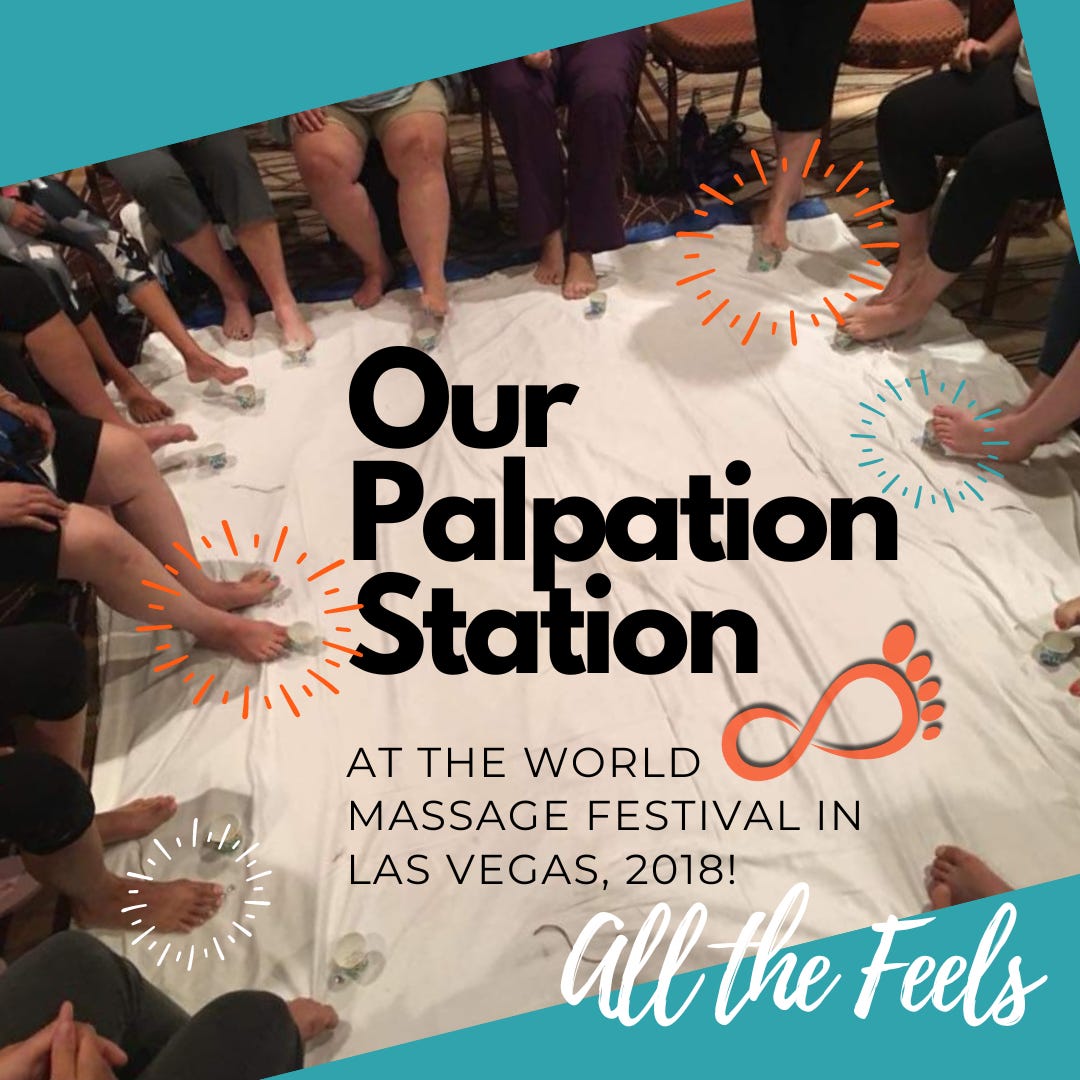
Your friend will need to lay all those things out and then cover them with the fabric sheet/blanket etc. Then you go on a scavenger hunt to feel and identify each of the things with your feet through that fabric. The thicker the fabric doesn’t always mean it’s harder to discern the “thing!” Sometimes the volume increase from the surrounding tissue, I mean fabric in this case, actually helps you find and feel the hidden objects easier.
Use the outside edge of your foot to scan the surface lightly and feel for ripples in the fabric that lead up to a buried treasure. Use your toes to fumble around and grab things. Use the ball of your foot to see how hard or squishy each thing is, and if you can push into it without it moving or causing you pain. Visualize what you are feeling – then when everything has been found, feel each thing with your hands and look at them to re-enforce and integrate the details that your feet just experienced. Did you guess what everything was correctly?
This is how we feel bodies with our feet. If you are a new Barefoot Massage Therapist, your palpation skills will develop with practice, patience, more practice, and trust. It’s encouraged that you step down and feel things that you think you felt with your foot, and confirm it with your hands. It’s also helpful to practice your new Barefoot Massage skills on bodies that you regularly massage with your hands, so you are familiar with their own buried treasures! And of course: know your anatomy. Know the topography of the bones, and the understand directions that the waves of muscles pull like tides in different positions and movements. Anatomical awareness in every stroke is a big focus in the Continuing Education classes we teach here at the Center for Barefoot Massage.
If you have zero intention of ever massaging humans professionally with your feet, then you can still develop them into smart feelers to help enrich your nervous system and whole body. Smart feet can make for better balance, better movement, better brains and a better quality of life. Take your shoes off and go barefoot more often!
Here is my Amazon list of things to stand on for smarter feet.
Feeling dirty:
This topic is also a very frequently THOUGHT question of the public when they imagine what a Barefoot Massage Therapist does. They may not come out and actually ask you if you clean your feet: but you can bring it up in conversation to ease their mind. A portion of the public may be entirely turned away from even just the idea of Barefoot Massage because feet are perceived to be “dirty”. Be the change you wish to see in the world and have the cleanest, softest, smartest feet in town! Whatever your massage license requires for sanitization and cleanliness of your hands needs to also apply to your feet. In some countries or states this may mean that polish is not permitted.
I personally notice that as a Barefoot Massage Therapist, if my feet are too dry and rough then I can’t feel anything BUT that. Maybe that’s the neurotic part of me more than my actual nervous system. The softer, smoother and cleaner that my soles and nails are, the more I can clearly “see” through my feet and feel with more detail and less distraction.
Here are my “every day at work” foot care tips:
- I use a Mr Pumice Purple pumice stone thing
- My nails are as short as they can be and filed to soft edges with a glass nail file
- I keep a nail brush with my office foot care baggie to scrub any exposed nail surface clean.
- I use PurePro’s Peppermint Pedango foot creme on my clients feet, which gets on my feet and feels/smells great for us both (save $10 off your first order with code BAREFOOT)
- I have a glass foot file to use before each massage to keep my heel edges smoothed.
For more of a monthly/weekly whatever schedule of foot care, pedicures are an option to partake in, DIY salt or sugar scrubs are always great, and for a deeper exfoliation, many people love the “Baby Foot” chemical treatment that literally leaves layers of your foot-skin peeling off. (Ew, but neat!)
Here’s an oldie but a goodie: a video of Mary-Claire showing a good trick to know if your feet are soft enough to massage with:
So, to answer the question “Can you feel things with your feet like you can hands…”
If you are a Barefoot Massage Therapist, be honest and educational with your clients so that when they go out into the world and talk about your work, they’ll have a more informed point of view. We hope to help your feet continue to learn through the barefoot work we teach at The Center for Barefoot Massage, and the info dished out in content like this!
We still believe that the future of massage is a foot!
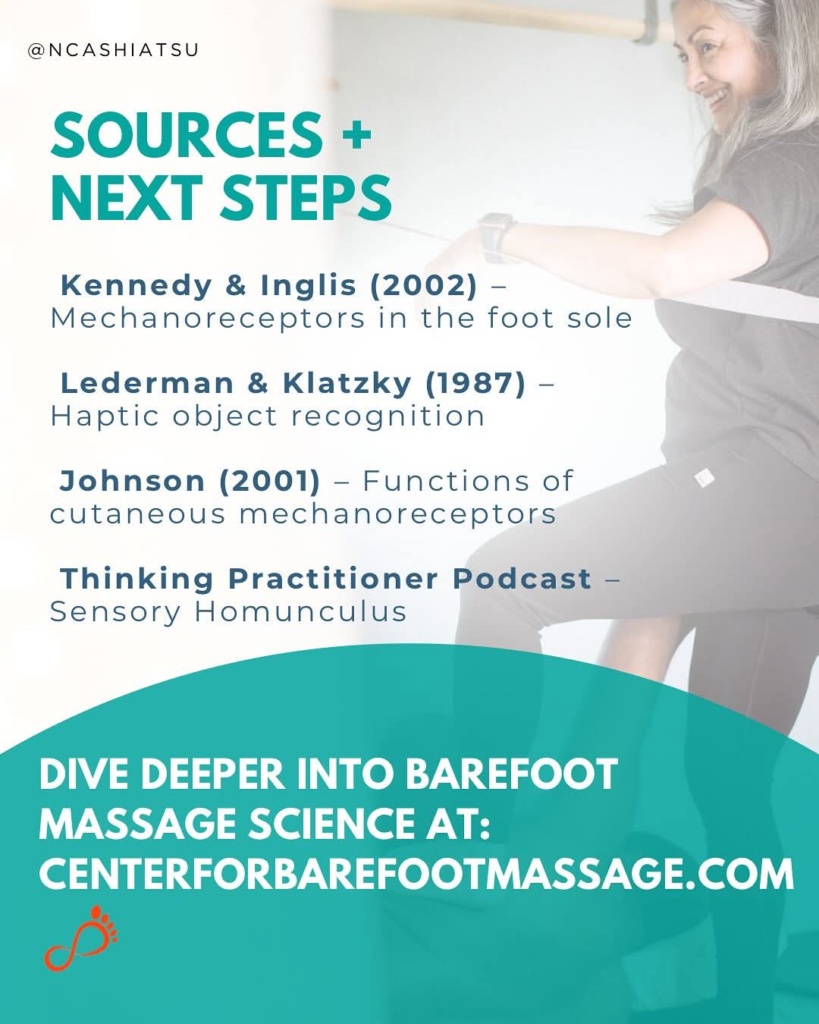 References
References
- The Center for Barefoot Massage’s original post and easier answer on this topic
- Kennedy PM, Inglis JT. “Distribution and behaviour of glabrous cutaneous receptors in the human foot sole.” J Physiol. 2002 Feb 1;538(Pt 3):995-1002. doi: 10.1113/jphysiol.2001.013087. PMID: 11826182; PMCID: PMC2290100.
- Vallbo AB, Johansson RS. “Properties of cutaneous mechanoreceptors in the human hand related to touch sensation.” Hum Neurobiol. 1984;3(1):3-14. PMID: 6330008.
- Ross, R.T., Randich, A. “Associative aspects of conditioned analgesia evoked by a discrete CS.” Animal Learning & Behavior 13, 419–431 (1985).
- Lederman, S. J., & Klatzky, R. L. (1987). “Hand movements: A window into haptic object recognition.” Cognitive Psychology, 19(3), 342-368.
- Johnson, K. O. (2001). “The roles and functions of cutaneous mechanoreceptors.” Current Opinion in Neurobiology, 11(4), 455-461.
- A great episode from the Thinking Practitioner Podcast about the homunculus sensation map.

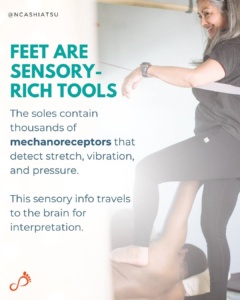
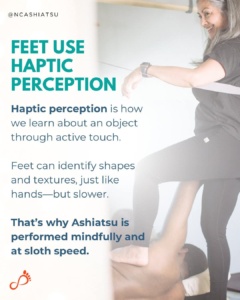
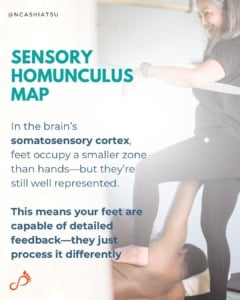
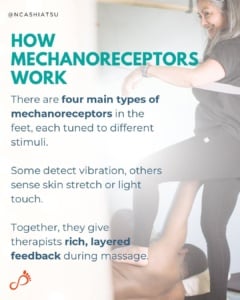
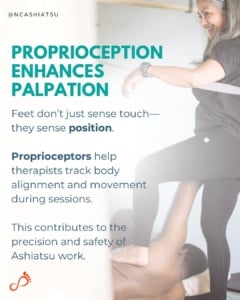
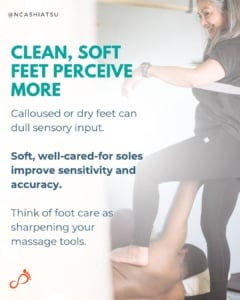
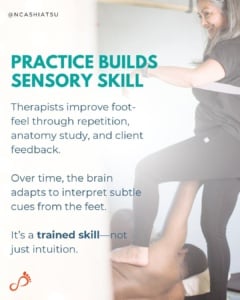




 Who needs to have an awesome tip like this? Share this quick and easy, inexpensive tip to help them improve their massage!
Who needs to have an awesome tip like this? Share this quick and easy, inexpensive tip to help them improve their massage!
